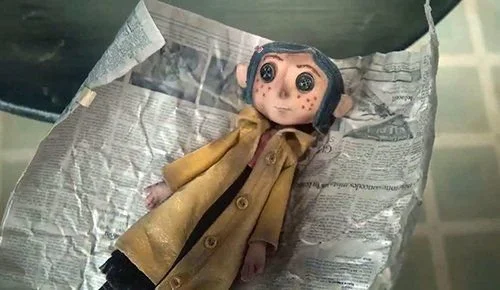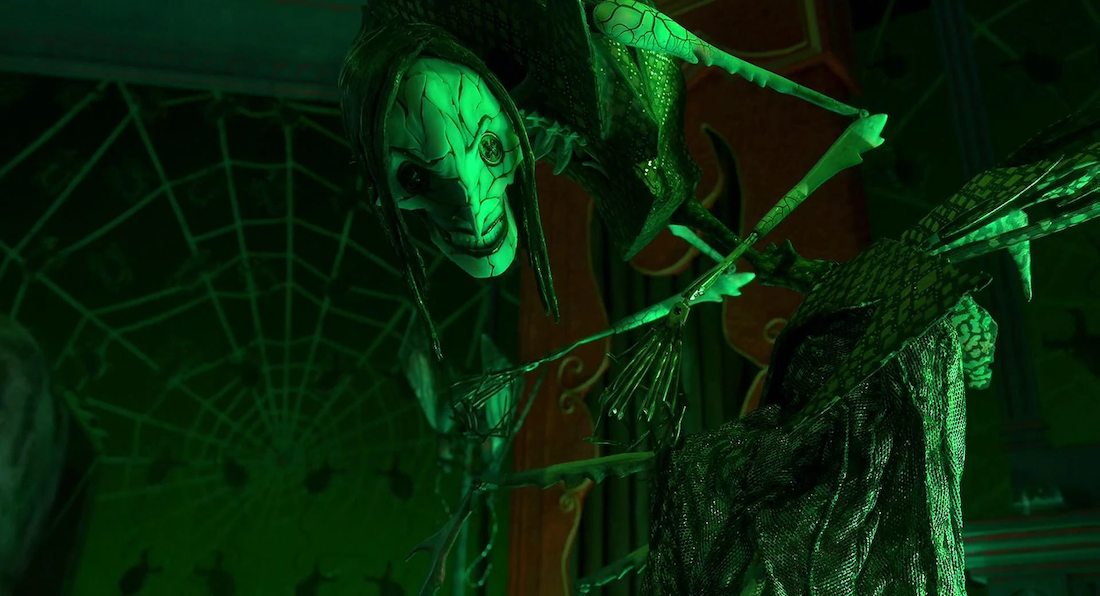CORALINE (2009)
When you’re indulging your appetite for horror, what scares you most? A haunted house filled to the brim with ghosts and ghouls, plucky teens being stalked through the woods by a masked killer, or maybe a seemingly innocuous object becoming the center of a rather petrifying poltergeist? I am a certified wuss, an unabashed one, so I’m not ashamed to admit any of these would easily elicit terror within me. I am, however, partial to haunted toys, primarily dolls, as they are easily my favorite cliche. Their uncanniness, versatility, and ubiquitousness makes them so fitting for any narrative, and the horror genre has etched a wonderful niche for these trinkets and playthings that really make them come alive (oftentimes quite literally). During this great month of Doll-O-Ween I wanted to platform a villain who perfectly embodies what it means to be a diabolical doll, but is often an afterthought to the Annabelles and Chuckies within the horror diapason. That’s right, I’m talking about Mother… the Other Mother, that is. Otherwise known as the Beldam and her darling dolls from Henry Selick’s CORALINE (2009). I remember first seeing it at a sleepover with a friend, the both of us so terrified we’d sought the company of her teenage sister (much to everyone’s chagrin). Safe to say, it’s found a forever home in my rewatch rotation.
The beginning sequence of the movie has been burned into my memory ever since that fateful first viewing. Gorgeous and grotesque, Laika Studios hit the ground sprinting for their first feature film. They impliment what I can best describe as “G-rated gore” that highlights children’s horror as its own distinguished sub-genre, not just a watered down or family friendly version of themes and archetypes that have ruled horror for decades. As the Other Mother’s needle-hands graze over a doll resembling a young girl, the audience watches in disgust as she disembowels the poor thing, gutting and ripping out all of its stuffing, snipping and tugging at various seams, even turning its entire body inside out in a nauseating display. The whole scene is extremely visceral, an abstraction of body horror that, to this day, curdles my blood. Seasoned CORALINE viewers also have the unpleasant hindsight of knowing the doll itself was all that remained of the missing Lovat girl, a depressing realization that sits in the stomach like a rock throughout the remainder of any rewatch.
Other films showcasing antagonistic dolls (both classic and contemporary) share many qualities, CORALINE being no different. Canonically, they move on their own, are possessed by a malevolent force, and even act as tethers between both realms in the movie. Pretty standard stuff, but with all that’s blatantly revealed (whether visually or through dialogue), there are still characteristics about the dolls that’re never explicity explained. Luckily, we have several speculations by fans to help piece together the many (and I mean many) micro-mysteries that persist throughout CORALINE.
There’s a very popular headcanon that the doll itself, or (more likely) the Beldam through the doll, is capable of entrancing people in the Real World to some extent. Some fans use this to assuage the inexplicable disappearance of Coraline’s parents, their own hastily fashioned doll compelling them to venture into the Other World as the Beldam’s final attempt to catch Coraline. Personally, I think the more bewitching properties of the doll provide a clever (and more interesting) explanation for how Wyborn and Coraline had such tame reactions to the initial discovery of the forgotten relic. I mean, they acknowledge the oddity of the situation, but then they both just kinda dropped it. Such a bizarre response is even reiterated when Coraline attempts to confront her peer about the dolly doppelganger only for the inquiry to be… completely ignored. Strange, even more strange is how casually the protagonist herself drops the topic with zero push-back. In fact, Coraline welcomes the doll into her life and routine seamlessly with no stage in which she grows attached, she simply is the second the doll comes into her possession. If you ask me, that’s the Beldam’s influence through the doll. Now, I can see some folks (who’re no fun) chalking these instances up to pacing, but separating the production of a story from the plot itself is needlessly disjointing. Narratives are partially shaped through the limitations of the medium they’re made in. To me, filling in the blanks is half the fun in analyzing a story. Maybe I’m getting ahead of myself, after all, there are plenty of canonical elements that we’ve yet to discuss.
Coraline’s doll isn’t the only one at the Beldam’s disposal. Everyone she meets at the Pink Palace has their own Other World copy-cat (besides, y’know, the cat) who is weaponized against the girl once she’s fully caught on to the Other Mother’s ruse. These aren’t some innocent toys whose bodies were commandeered by an otherworldly force, but a series of puppets crafted and used by the Beldam herself in order to ensnare her prey. Their very existence was nothing more than a trick up the witch’s sleeve, proxies for nefarious deeds. This isn’t to imply that her henchmen were superficial characters in a greater narrative. Being extensions of the Beldam gave the dolls a lot more weight in their significance to the story and greater lore that permeates throughout CORALINE. Most of the iconic horror movies that star possessed or otherwise supernaturally inclined figurines are set in some version of our reality. In this film, however, the audience is privy to both realms. Usually such a clearly defined system of magic and rigid explanations behind paranormal happenstances can feel limiting, but the fact that the Beldam’s influence is so localized only adds to the complexity of CORALINE. Besides, it’s made abundantly clear through characters like the cat and everyone’s favorite lesbian thespian, Miss Spink, that magic prevails throughout the universe. These two minor characters singlehandedly add so much depth to the movie’s world in terms of magic, how it operates, and how its various forms are able to compliment, compound, and combat one another. I digress, CORALINE is far from a concise story and not everything introduced in the plot is given a thorough explanation.
Depending on who you ask the movie’s details raise more questions than it answers. Something that isn’t even acknowledged in the movie is the fact that the filler used for Coraline’s version of the doll is sand, while (as seen in the intro) it was originally stuffed with cotton. Again, we must look to Reddit and Tumblr for fans who can offer us some form of answer or explanation. There’s (plenty) hearsay in regards to the sand having supernatural properties with some fans going so far to theorize that it’s what gives the doll its ability to spy on Coraline and even independently move around the Real World. I hate this answer, not because it’s implausible or far-fetched (quite the opposite), but because it doesn’t address the fact that the doll had previously been filled with a completely different material. CORALINE is filled with these little perplexities, another example is how the Beldam gets Coraline from the Other World to her bedroom. While the setting transition is beautiful, I don’t think Other Bobinsky’s circus “mice” were dragging an unconscious Coraline through the Pink Palace and into her bed.
The Beldam is easily Laika’s scariest looking antagonist, but she is ultimately a non-threat without her creepy ass dolls. They’re the only reason she’s able to prey on children, because at the end of the day her personality is one big red flag. Coraline herself is never comfortable around her and only lowers her defenses after being showered in treats and presents. The dolls, whether it’s the Other Father or Coraline’s mini-me, possess all the charm and charisma the Beldam doesn’t have. Closer to the finale it becomes glaringly obvious that at least some of the dolls aren’t comfortable with the Beldam’s schemes. Considering she was the one who brought them to life you’d assume they’d mindlessly go along with whatever she said, but the Other Father and Other Wyborn both make it known that they don’t endorse her actions. It’s chilling thinking about how their entire existence was spent living in fear, under the thumb of their creator who they could either oblige or face certain annihilation.
The dolls are as good as they are evil, as complex as they are simple, and as scary as they are sweet. CORALINE has something for everybody. Maybe you’re frightened by the Beldam’s sadistic grooming of her next meal, or the inescapable hopelessness of the Other World, or perhaps the frankly nauseating visuals of once welcoming characters becoming disfigured as the Other Mother’s magic weakens. Regardless, the nexus that connects one theme to another, that bridges the worlds within the movie, and tethers even the most unlikely of characters to one another are those freaky dolls.




